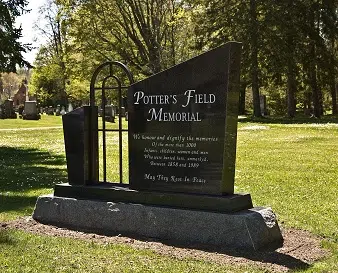A monument to 1,200 previously unmarked graves can now be viewed at the Potter’s Field in Owen Sound’s Greenwood Cemetery.
It was unveiled Monday north of the chapel on the east side of the ravine.
Monument project volunteer Aly Boltman says the historically overlooked Potter’s Field, also known as the Indigent Lot, came into use in 1858 and was a burial ground for more than 130 years for babies, orphans, seniors, Indigenous people, the working poor, the incarcerated and the homeless are buried there.
Boltman says many from Owen Sound’s historic Black community, including those who escaped on the Underground Railroad and their descendants, share the resting place, “These were citizens who faced systemic racism, often resulting in deep poverty,” says Boltman.
The monument was installed at Greenwood Cemetery in December 2020 and was covered for the winter in anticipation of a spring community dedication, but the pandemic has made scheduling an unveiling difficult.
Boltman says the warmer weather is bringing more people out to community parklands, “People are enjoying their greenspaces more than ever before. There are so many people in Greenwood Cemetery right now, we though it was time to show it to the community and it’s now unveiled,” says Boltman.
The volunteer effort to mark the Potter’s Field with a monument began in 2018, during the Doors Open event, during which Boltman led a tour of the Potter’s Field.
At the outset, two anonymous donors volunteered to fund a monument to honour the people buried in Potter’s Field. Those donors have since been revealed to be John and Shirley Reaburn of Georgian Bluffs, who were moved by the absence of any graveside markers. They say in a statement, “This day and age, there is no need for anyone to be left unrecognized.”
A volunteer committee gathered community input on the monument’s design, and alongside Sanderson Monuments, they came up with a design inspired by by the first local British Methodist Episcopal Church’s arched windows and the Black History Cairn designed by Bonita Johnson deMatteis at Harrison Park.
Boltman hopes to do more tours in the future, once pandemic safety measures allow for it, and plans to have an official dedication ceremony in the fall.
Owen Sound Mayor Ian Boddy, a relative of John Boddy, the first person interred in Potter’s Field in 1858, says in the release, “The Potter’s Field Monument celebrates and recognizes more than 1000 unidentified, but not forgotten interred people. We are grateful to have a permanent monument to pay tribute to and honour those in Potter’s Field.”
Meanwhile, York University Professor Naomi Norquay is leading a Potter’s Field research project, in partnership with Grey Roots Museum & Archives and funded by the Federal government.
The project’s findings will eventually be available online and linked through an interpretive plaque to be installed at the memorial.
To learn more about Potter’s Field, you can watch “Caring for the dead: A look at who’s buried in Greenwood Cemetery’s indigent Plot or review the interment list.
Podcast Play about one of the most well-known people buried in the Potter’s Field, John Daddy Hall, called Come Home – The Legend of Daddy Hall, by Audrey Dwyer runs at the Tarragon Theatre in Toronto starting premieres May 30th.
If you would like to provide information for the Potter’s Field research project, email: ospfproject@gmail.com



